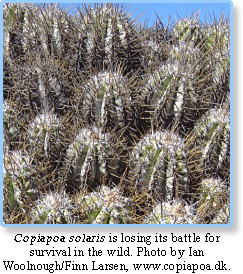– Copiapoa solaris (2015)
 By Chris Deem (February 2015)
By Chris Deem (February 2015)
I didn’t know who had sent it, for the envelope was not signed. The moment I saw it, I knew the ugly photograph would linger in my memory. I just stood there looking at it, feeling like someone being called to bear witness, not knowing where or why.
As I looked, I found myself wishing that the bleak landscape might instead have been photographed at night. It would have seemed nicer then. A charcoal night would have softened the stark hills with silky gray shadows of darkness. The sky might have been filled with the clarity of a million stars. That, unfortunately, isn’t what happened.
The ugly image had captured the cold nakedness of day. It revealed a milky sky that draped the empty hills like a shroud. I looked at the clumps of Deuterochnia chrycantha plants that were scattered across the gray soil like desiccated memories.
It was hard to look at the copiapoas. Their stems were shrunken. Many were blackened. Many were already dead. As I looked, I wondered if plants could feel desperation or pain. I hoped not.
It was the kind of ugly photograph that would linger in my memory. I never learned who sent it or why.
In the book Copiapoas in Their Environment, there was both sad and hopeful information on the species Copiapoa solaris. According to the authors, this species is found in four known locations.
Sadly, in three of the four locations, this species is slowly losing its battle for survival. Still, there is a place of hope in the Botija Valley. I read that it is the only known location where a mostly healthy population of this species still survives.
This is only one of several interesting species in this genus. Bring in your own favorite Copiapoa species for February’s Plant of the Month.
